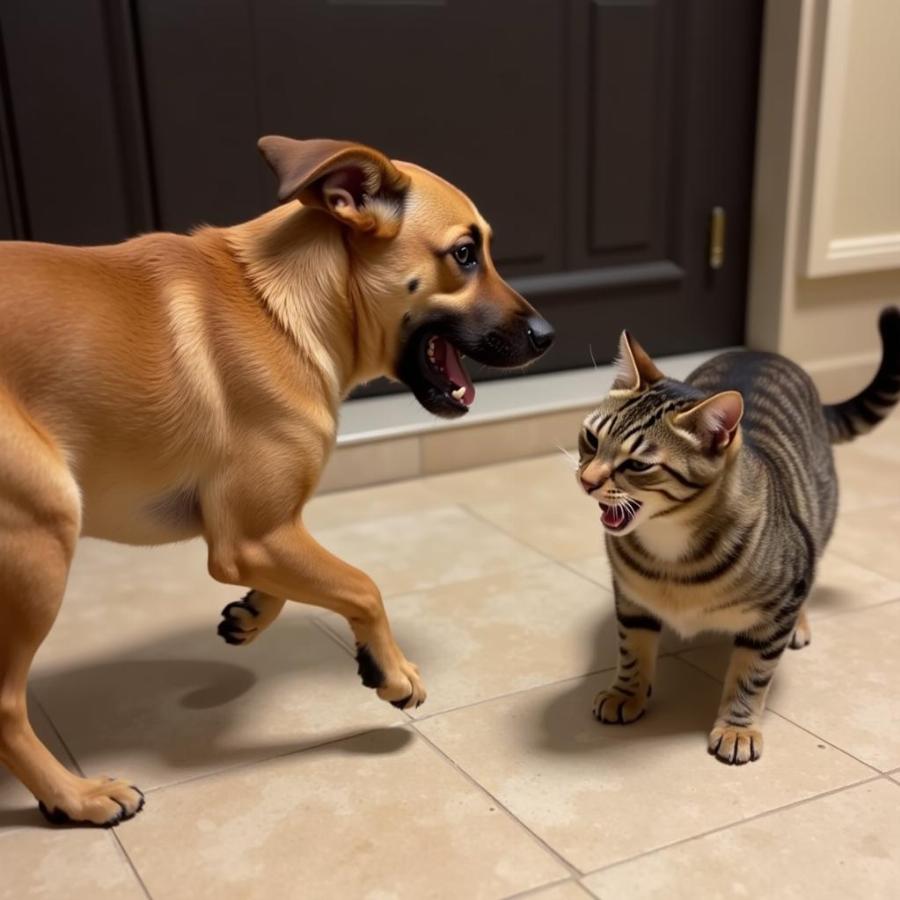When you search “dog kills a cat,” you’re likely grappling with a distressing situation and searching for answers. Perhaps your dog has harmed a cat, and you’re unsure of what to do next. This article, specifically tailored for owners of purebred dogs, will explore this complex issue, offering guidance and resources to help you navigate this difficult time.
Why Do Dogs Kill Cats?
Several factors can contribute to a dog attacking and killing a cat. It’s important to understand that this behavior doesn’t necessarily mean your dog is inherently vicious. It’s often a complex interplay of instinct, training, and circumstance.
- Prey Drive: Many dogs, especially those bred for hunting or herding, have a strong instinct to chase and sometimes kill small, fleeing animals. This is a deeply ingrained behavior, even in breeds typically considered gentle.
- Lack of Socialization: Dogs who haven’t been properly socialized with cats, especially during puppyhood, may not recognize them as friendly housemates. They might view cats as prey or a threat.
- Territoriality: A dog might attack a cat if they perceive the cat as invading their territory, especially if the cat is new to the home or environment.
- Fear or Anxiety: A fearful or anxious dog might lash out defensively if they feel threatened by a cat, even if the cat isn’t being aggressive.
- Learned Behavior: If a dog has successfully hunted and killed a cat before, they’re more likely to repeat the behavior.
 Chó cảnh tấn công mèo
Chó cảnh tấn công mèo
What to Do if Your Dog Kills a Cat
This is undoubtedly a traumatic experience. It’s crucial to act responsibly and address the underlying issues to prevent future incidents.
- Ensure Safety: Immediately separate the dog and any remaining cats. Attend to any injured animals, seeking veterinary care as needed.
- Consult a Professional: Contact a certified professional dog trainer or veterinary behaviorist. They can assess your dog’s behavior and create a tailored training plan.
- Management and Prevention: Implement strict management strategies to prevent future interactions between your dog and cats. This might include keeping them in separate areas of the house, using crates or baby gates, and always supervising any contact.
- Training and Behavior Modification: Work closely with your trainer or behaviorist to address the root causes of the aggression. This might involve desensitization and counter-conditioning techniques, as well as teaching alternative behaviors.
Preventing Dog-Cat Conflicts
Prevention is always the best approach. Here are some tips for fostering peaceful coexistence between dogs and cats:
- Early Socialization: Introduce puppies to cats early and often, in a controlled and positive environment.
- Supervised Interactions: Always supervise interactions between dogs and cats, especially initially.
- Provide Separate Spaces: Ensure both dogs and cats have their own safe spaces where they can retreat and feel secure.
- Positive Reinforcement: Reward calm and appropriate behavior around cats.
- Consult a Professional: If you’re unsure how to introduce a dog and cat, or if you’re experiencing any challenges, consult a professional trainer.
Can a Dog That Has Killed a Cat Be Rehabilitated?
if a dog kills a cat will it kill again While there’s no guarantee, many dogs can be successfully rehabilitated with professional help and consistent effort. The key is to identify the underlying causes of the aggression and implement appropriate training and management strategies.
What if my dog shows aggression towards other small animals after killing a cat?
dog kills cat This is a serious concern and warrants immediate professional intervention. Consult with a veterinary behaviorist to address this escalated aggression.
Is it safe to introduce a new cat after my dog has killed one?
cat kills dog This is generally not recommended, especially if the underlying aggression issues haven’t been fully resolved.
Conclusion
Dealing with a dog that has killed a cat is a challenging situation. By understanding the potential causes of this behavior, taking appropriate action, and seeking professional guidance, you can work towards preventing future incidents and potentially rehabilitating your dog. Remember, responsible pet ownership involves addressing these issues head-on and prioritizing the safety and well-being of all animals involved.
FAQ
- Why do some dogs have a strong prey drive? Prey drive is an instinctive behavior, often strengthened by breeding.
- How can I socialize my puppy with cats? Introduce them gradually in a controlled, positive environment.
- What should I do if my dog chases my cat? Interrupt the chase and redirect your dog’s attention.
- Can a dog that has killed a cat live safely with other cats? With professional help and consistent management, it’s sometimes possible.
- What type of professional should I consult for dog aggression? A certified professional dog trainer or veterinary behaviorist.
- Is it my fault if my dog kills a cat? While it’s important to take responsibility for your dog’s actions, assigning blame isn’t always helpful. Focus on addressing the underlying issues.
- How can I prevent my dog from killing another cat? Implement strict management strategies, work with a professional trainer, and prioritize safety.
Suggested Further Reading
You might also find these articles helpful:
Beaut Dogs: Your Trusted Source for Purebred Dog Information
Beaut Dogs is your go-to resource for all things purebred dogs, providing expert advice, insightful articles, and a passionate community of dog lovers. We offer comprehensive information on breed characteristics, health, training, nutrition, and much more. When you need expert assistance, contact us at Email: [email protected] for detailed and accurate answers from Beaut Dogs. We’re dedicated to helping you provide the best possible care for your canine companion.